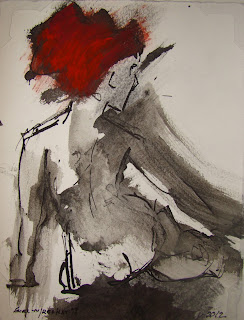I have friends who are Kawasaki writers. They sit down,
fingers at the keyboard, and within one hour type 100 pages; pages that
actually make sense and they only edit once—maybe.
If lucky, I type one new sentence an hour while editing. I
don't daydream and I'm not stuck. But new words keep popping up and I want the
perfect word. I work with the same slow deliberation in my drawings and
paintings and, sometimes, I have to step away.
There are no exciting verbs to describe a slow-working
deliberate artist.
I stepped away longer than I intended because I had to
rethink my blog. I didn't want to write about feeling good during my education
because a learning curve is painful—no pain, no learning curve. Remember your
frustration during high school and college math classes You had to take to
graduate? Carry those feelings forward into starting and maintaining a
profession—plus the artistic frustrations.
Sometimes "flounder" is a fish and sometimes it's
a verb. That must be where the notion of the tortured artist lies. One of my
professors had said, all artists have a flat forehead from hitting it with
their hand as they finally "get it."
I knew what I did not want to blog about: not how-to(s)
about technique, brushes, canvases, etc., and certainly not when excellent
how-to(s) by other artists keep coming onto the internet.
Previously, while I worked on commissions my life had
revolved around my clients' needs and the preconceptions they brought to our
meetings because portraiture is highly personal and intimate. Everyone
remembers a different parent's face or sibling's face from decade-to-decade.
I.e., my older brother remembered a youthful active mother while I remembered a
mother who was slowly dying.
I made quite a list of what I did not want to write. Though
I had written about family resemblance and the importance of unique names, I
had spent my 50 years painting, not writing.
In her essay "On Keeping a Notebook" Joan Didion
wrote "I wanted to remember what it was to be me." My paintings,
drawings, and portraits are my journal and I want to remember what it was to be Ida. I
want to remember my clients, and my clients' stories. Portraiture is about the
human body (that's my part) but my clients' motivations to seek out a portrait
painter is because love, as an emotion, comes in a variety of shapes, just
as many shapes as there are people and moments of loving.
Instead I developed a different list of questions—see,
learning never stops. Why should anyone care about the education of a basically
unknown artist? How do I write interestingly?
I decided to write about what I learned from my 1,001 mistakes
in marketing, lecture tours, public relations, sales, influences from others
and elsewhere, my own memories, and finally what I learned from my clients. I
fell in love with the families I met and also discovered I really enjoy the
business part of art.
These are my reasons for the two-year gap—learning how to
"say it" by a lot of thinking and working with other writers.
I'm back.
Ida Kotyuk©
If you get fewer than 2,000
rejections a year, you are not working hard enough.
